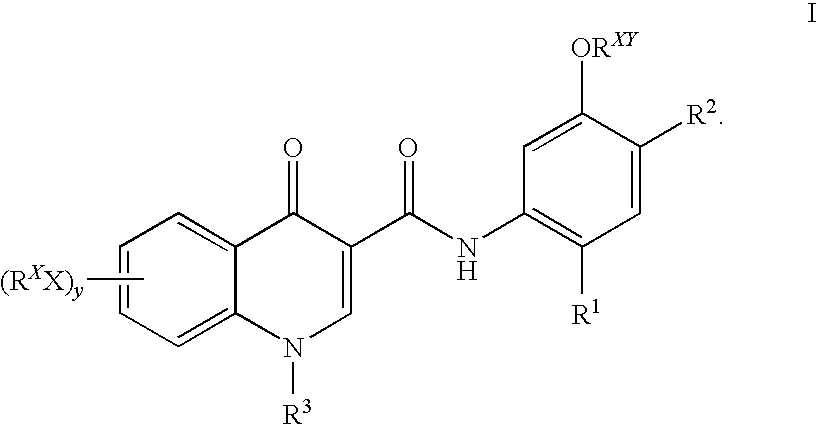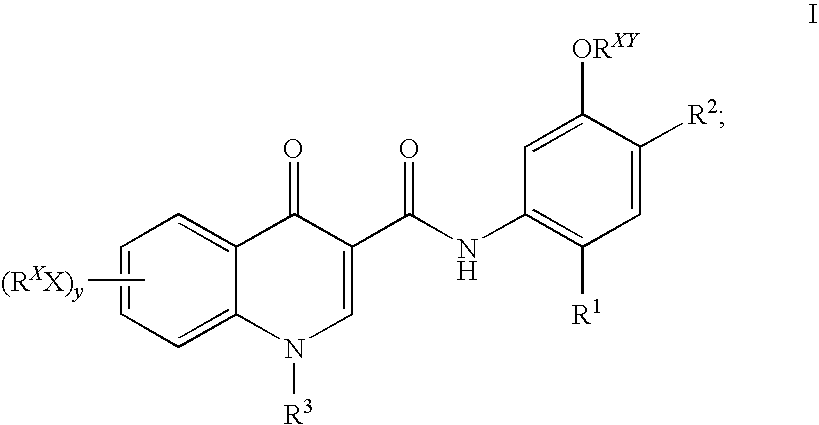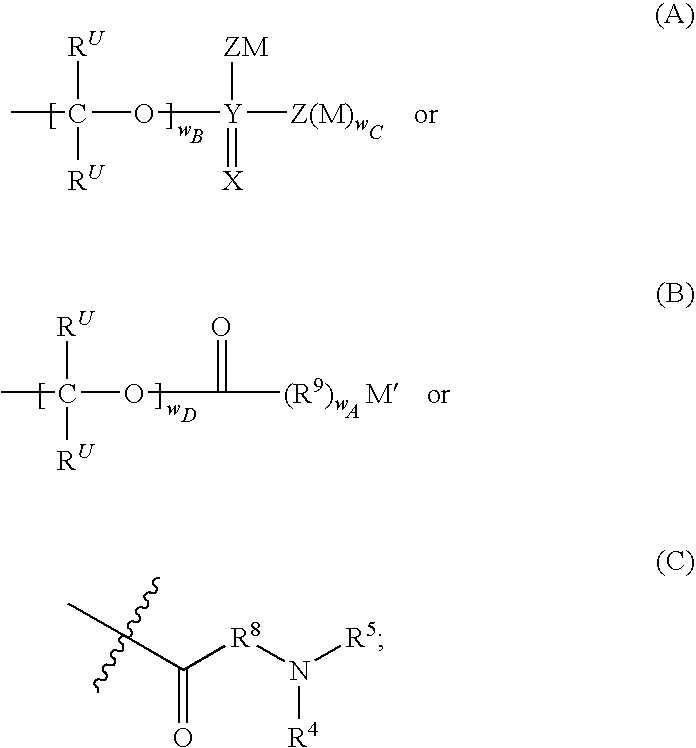Prodrugs of modulators of ABC transporters
a technology of transporter and modulator, which is applied in the field of prodrugs of abc transporters, can solve the problems of imbalance in ion and fluid transport, debilitating and fatal effects of cf, and reducing anion transport, so as to improve aqueous solubility, enhance bioavailability, and suit formulations.
- Summary
- Abstract
- Description
- Claims
- Application Information
AI Technical Summary
Benefits of technology
Problems solved by technology
Method used
Image
Examples
example 1
[0284]
[5-[(4-oxo-1H-quinolin-3-yl)carbonylamino]-2,4-ditert-butyl-phenoxy]phosphonic acid dibenzyl ester
[0285]Tetrazole (0.45 M solution in CH3CN, 1.24 mL, 0.56 mmol) was added to a mixture of N-(5-hydroxy-2,4-ditert-butyl-phenyl)-4-oxo-1H-quinoline-3-carboxamide (78 mg, 0.2 mmol) and dibenzyl diisopropylphosphoramidite (184 μL, 0.56 mmol) in dichloromethane (2 mL) and the reaction was stirred at room temperature for 2 h, then tert-butyl hydroperoxide (5.5M solution in decane, 102 μL, 0.56 mmol) was added and the reaction was stirred at room temperature overnight. The reaction mixture was then partitioned between ethyl acetate and saturated NaHCO3 solution. The organic layer was washed with brine, dried over MgSO4 and concentrated. The residue was adsorbed onto silica gel and purified by column chromatography (silica gel, 50-100% ethyl acetate—hexanes) to yield [5-[(4-oxo-1H-quinolin-3-yl)carbonylamino]-2,4-ditert-butyl-phenoxy]phosphonic acid dibenzyl ester as a clear oil (80 mg, 6...
example 2
[0288]
[4-(3-ethoxyphenyl)-5-[(4-oxo-1H-quinolin-3-yl)carbonylamino]-2-tert-butyl-phenoxy]phosphonic acid dibenzyl ester
[0289]Tetrazole (0.45 M solution in CH3CN, 12.4 mL, 5.6 mmol) was added to a mixture of N-[2-(3-ethoxyphenyl)-5-hydroxy-4-tert-butyl-phenyl]-4-oxo-1H-quinoline-3-carboxamide (912 mg, 2 mmol), dibenzyl diisopropylphosphoramidite (1.84 mL, 5.6 mmol) in dichloromethane (2 mL) cooled in an ice-water bath. The reaction was stirred for 2 h while warming to room temperature, then more dibenzyl diisopropylphosphoramidite (1.00 mL, 3.0 mmol) was added and the reaction was heated to reflux for 3 h. The reaction was then cooled in an ice-water bath while tert-butyl hydroperoxide (5.5M solution in decane, 1.02 mL, 5.6 mmol) was added and stirred at room temperature overnight. The reaction was partitioned between dichloromethane and saturated NaHCO3 solution. The organic layer was washed with brine, dried over MgSO4 and concentrated. The residue was adsorbed onto celite and puri...
example 3
[0293]
[5-[(4-oxo-1H-quinolin-3-yl)carbonylamino]-2,4-ditert-butyl-phenyl]2-diethylaminoacetate. HCl
[0294]To a mixture of N-(5-hydroxy-2,4-ditert-butyl-phenyl)-4-oxo-1H-quinoline-3-carboxamide (3.92 g, 10 mmol), DMAP (8.54 g, 70 mmol) and diethylamino-acetic acid (2.62 g, 20 mmol) in dichloromethane (35 mL) was added N-(3-dimethylaminopropyl)-N′-ethylcarbodiimide (5.75 g, 30 mmol). The reaction was stirred at room temperature for 3 days. The reaction mixture was washed with water, dried over MgSO4 and concentrated. The residue was dissolved in DMSO and purified by reverse phase HPLC (10-99% CH3CH—H2O with 0.5% TFA) to yield the product as a TFA salt. A portion of this product (130 mg) was dissolved in dichloromethane and extracted with saturated NaHCO3 solution, dried over MgSO4 and concentrated to yield the freebase; 1H-NMR (400 MHz, d-DMSO) δ 12.93 (br s, 1H), 12.05 (s, 1H), 8.87 (s, 1H), 8.33 (dd, J=8.2, 1.1 Hz, 1H), 7.82 (m, 1H), 7.75 (d, J=7.8 Hz, 1H), 7.52 (m, 1H), 7.42 (s, 1H)...
PUM
| Property | Measurement | Unit |
|---|---|---|
| temperature | aaaaa | aaaaa |
| humidity | aaaaa | aaaaa |
| humidity | aaaaa | aaaaa |
Abstract
Description
Claims
Application Information
 Login to View More
Login to View More - R&D
- Intellectual Property
- Life Sciences
- Materials
- Tech Scout
- Unparalleled Data Quality
- Higher Quality Content
- 60% Fewer Hallucinations
Browse by: Latest US Patents, China's latest patents, Technical Efficacy Thesaurus, Application Domain, Technology Topic, Popular Technical Reports.
© 2025 PatSnap. All rights reserved.Legal|Privacy policy|Modern Slavery Act Transparency Statement|Sitemap|About US| Contact US: help@patsnap.com



